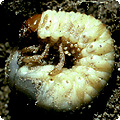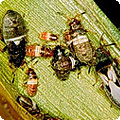There are several species in this category of insects that damage lawns in our area. Unlike grubs, which live in the soil, these critters typically live in the thatch, which is a layer of living and dead roots, stems, clippings and organic matter which accumulates on the soil surface. When this layer exceeds ¾ of an inch, it becomes a perfect environment for surface insects to harbor. It also restricts the downward movement of insect controls from reaching their target area. Core aeration is a good maintenance practice to keep thatch in check before it becomes a problem.
Hairy chinch bugs are periodic surface-feeding pests that cause serious damage to lawns in our area. Infestation usually occurs in fine fescue lawns with a layer of thatch. Damage is most prone to turf that is exposed to full sunlight during periods of hot, dry weather. Injury to turf is caused by adult and nymph chinch bugs sucking sap from the crowns and stems of susceptible grasses. Extensive feeding causes grass to first turn yellow and then reddish brown. This is often mistaken by homeowners for drought stress and left untreated, it will leave large unsightly dead areas when the rains and cooler weather of fall return. When diagnosed, insecticide treatments can provide excellent control, but does not prevent pest migration from untreated areas.
Billbugs are the most common cool season pests in North America. Damage can be difficult to identify and is often mistaken for drought stress, chinch bug or white grub damage. Billbugs infest most cool weather grasses including Kentucky bluegrass, perennial ryegrass and fine or tall fescues. Adult females chew a hole in the stems of turf grasses and deposit their eggs inside. The young larvae tunnel inside feeding on the host plants stem. The larvae leave the stem and feed on the crown and roots of the plant when it gets larger. Billbug adults puncture and feed through small wounds in turf stems, but produces no noticeable damage. Billbug infestation is diagnosed by tugging out affected stems. The damaged turf should easily break off revealing piles of sawdust like material, which is produced during feeding.
Billbug adults are located in the turf canopy but are often found walking across sidewalks and driveways during sunny weather. Chemical control is difficult because larvea spend the majority of their life inside plant stems and adults have a hard, armorlike exterior that does not easily absorb insecticides. Effective control requires precise understanding of the insects biology and proper application technique.
Caterpillar type lawn pests like cutworms, armyworm and sod web worms also live in the thatch layer and upper surface of the soil. They damage turf by chewing off the grass blades and shoots primarily during the nighttime hours. It often first appears as circular patches of dead grass closely cut off near ground level. When diagnosed, insecticide treatments can provide excellent control, but does not prevent pest migration from untreated areas.


